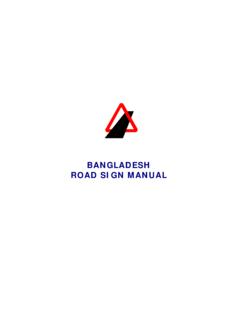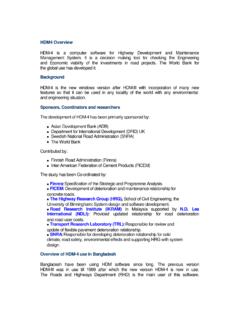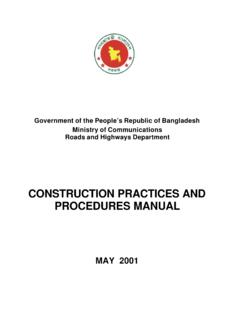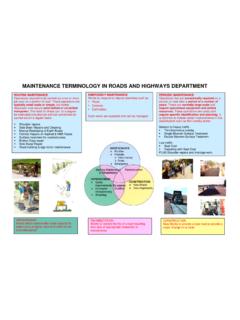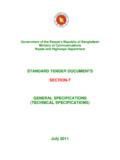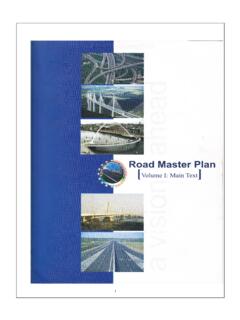Transcription of Vertical Alignment - rhd.gov.bd
1 Geometric Design of RHD Roads30 Vertical Vertical Alignment of a road consists of a series of straight grades and Vertical Vertical curves smooth the passage of vehicles from one grade to another and enable sightdistance to be maintained over the summit of a rise. Convex Vertical curves are called summitor crest curves, and concave Vertical curves are known as sag curves. At crest curves theminimum length is determined principally by the need to provide the required sight distance,though appearance is also a consideration. On sag curves sight distance is generally not aproblem, at least in daylight, but satisfactory results can be obtained by designing them in thesame way as crest of CurveThe recommended form of Vertical curve is the parabola (see Figure ). It is convenient todefine parabolic Vertical curves by the length of curve required for a change of grade of 1%,this being a constant for the parabola:K = L/Awhere:K = length required for a 1% change of gradeL = length of Vertical curve (assumed to equal length in plan)A = change of grade in %The K value is effectively an expression for degree of curvature (multiplying K by 100 givesthe equivalent radius of the Vertical curve).
2 Table contains the K values for eachcombination of road type / design speed / sight distance. Knowing K and A it is a simplematter to calculate L (see next section).Figure General Form of Parabolic Vertical Crest CurveL+ G%1- G%2 Note:A = G% - (-G%) = (G% + G%)1212 Geometric Design of RHD the Curve ParametersVertical curves are specified in terms of their length L (or LVC - Length of Vertical Curve).A step by step guide to determining L is set out below:1. Decide what sight distance to useThe Intermediate Sight Distance (ISD) provides a good starting point for curve design. Inhilly terrain it is advisable to use the Stopping Sight Distance (SSD), as this will be moreeconomic and will maximise the overtaking sight distance available on the gradients eitherside of the curve. Single lane roads and dual carriageway roads should always be designed toprovide Use Table to determine the K valueKnowing the road type and the design speed, and having selected a sight distance, read off theappropriate value for K in Table Calculate A Knowing the gradient of the road on each side of the Vertical curve calculate A (the change ingrade in % - see Figure ).
3 Refer to Table to determine whether the change in grade issufficient to make a Vertical curve necessary4. Calculate the length of the curveIn most cases L = K x A (but see next step for exceptions)5. Carry out cross-checksCompare L with the minimum length of Vertical curve required for acceptable appearance(Table ) and increase L if necessary. If the sight distance might be longer than the verticalcurve (such as could occur with the higher design speeds or the use of OSD) recalculate thecurve length using L = 2S 960/A where S = sight distance (sight distances are given inTable ). Use the curve length which is the Check for feasibility amend if necessaryIf site constraints or costs prevent a Vertical curve of this length being provided, checkwhether a curve to SSD requirements will be feasible.
4 Do not use curves whose radius isbetween the ISD and SSD standards as these could tempt drivers to overtake when there is notenough visibility curves must be clearly non-overtaking (SSD standards) or clearlyovertaking (at least ISD, and preferably OSD).Table Minimum Vertical Curve K ValuesSingle LaneRoads ( )Two Lane SingleCarriageway Roads( and carriageway)Dual CarriagewayRoads(2 x )DesignSpeed(km/h)ISDSSDISDOSDISD30 42418-40 94935-50 189187018653518351403580-357027070100-70 140540140 Notes:1. To calculate curve length use equation L = K x A where A is the algebraic difference in gradients2. For the higher design speeds and OSD recalculate the curve length using L = 2S 960/A where S = sight distance (fromTable ) and then use the higher of the two curve lengths3. Use Table to check that the curve length exceeds the minimum length required for a good appearance increase thecurve length as necessarySource: adapted from Table , RMSS, Vol.
5 V11 AGeometric Design of RHD Roads32 Table Vertical Curve Appearance CriteriaDesignSpeed(km/h)Maximum Change of GradePermitted Without Use of aVertical Curve (%)Minimum Length ofVertical Curve for GoodAppearance (m) : adapted from Table & , RMSS, Vol. sets out the maximum limits on gradients. In flat terrain (most of Bangladesh) the3% grade limit will ensure that the roads provide a good level of service for all types of trafficincluding non-motorised vehicles (NMVs). The choice of grade limits for rolling and hillyterrain reflects the fact that there is a high proportion of overloaded trucks and buses on ourroads. There is generally very little NMV traffic in these Maximum GradientsMaximum Gradient %Design TypeDesignSpeedPlainRollingHillyAll DesignTypesAll DesignSpeeds0 - 31 - 51 7 Source: adapted from Table , RMSS, Vol.
6 V11A Worked Example1) Assumptions: Design Class C; carriageway; 65km/h design speed; at thesummit where the curve is needed the grade goes from +6% to 4%; ISD ) Table indicates that the minimum K value for ISD on 65km/h roads is ) A = 6% (-4%) = 10% This is well in excess of the maximum change of gradespecified in Table , so a Vertical curve is ) L = 35 x 10 = 350m5) L is well in excess of the minimum length of curve for good appearance, so it isacceptable [Table ]. Recalculating L in case sight distance is longer than the curvegives L = (2 x 180) 960/10 = 264. [Table indicates that ISD for a 65km/h designspeed is 180m]. A curve length of 350m is selected.
